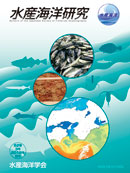We investigated the yearly changes in catch size of female snow crabs (Chionoecetes opilio) landed at a fishery cooperative (Echizen-cho Fisheries Cooperative Association), based on data obtained from consignment sales transaction documents. The catch size by brand was investigated immediately after the opening of the season in 2006, 2011, and 2016. This data, together with the results of carapace width composition measurements by brand, conducted by a fisheries research institute, were used to estimate the average carapace width of the catches. While the brand composition shifted towards brands for smaller crabs, the carapace width composition by brand became larger. The estimated average carapace width in 2011 was smaller than that in 2006, but was bigger in 2016. Based on these results, we conclude that the reduced size in brand composition in the market did not correspond to a smaller overall carapace width composition in the catches. The determination of data based on daily commercial transactions and annual measurements of carapace width is a useful method for continuous data generation.
View full abstract
